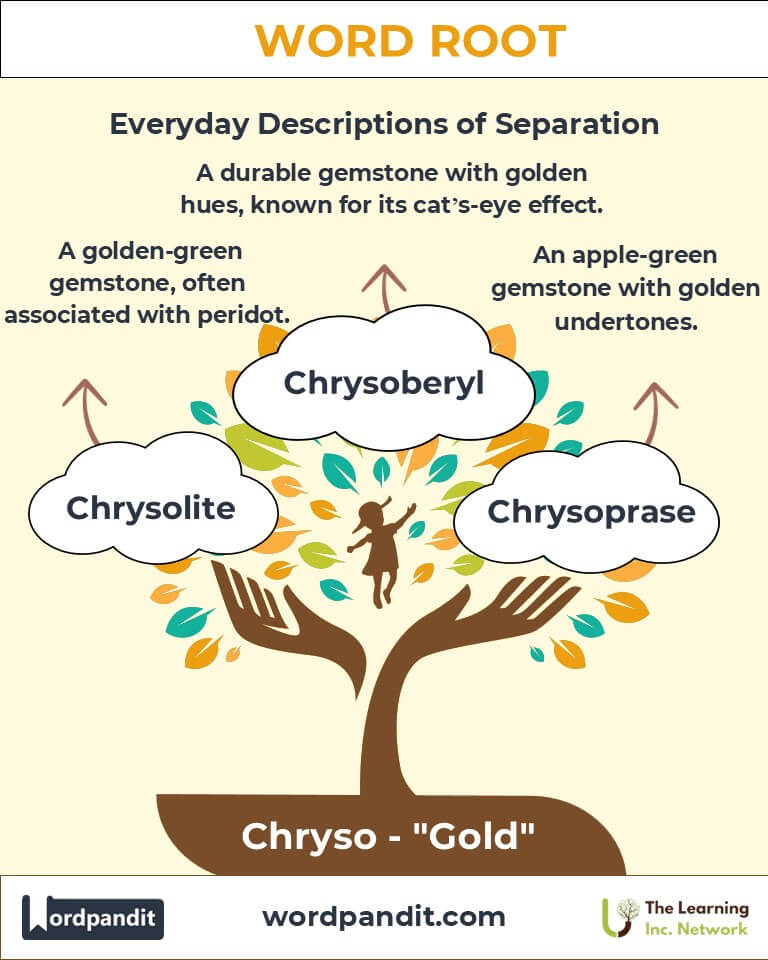Chryso: The Golden Touch in Language and Culture
Discover the allure of the word root "chryso," originating from the Greek word "khrusos," meaning "gold." This luminous root infuses language with radiance, symbolizing wealth, beauty, and divinity. From glittering gemstones to vibrant flowers, "chryso" connects us to timeless elegance and cultural treasures.

Table of Contents
- Introduction: The Essence of Chryso
- Etymology and Historical Journey
- Mnemonic: Unlocking the Power of Chryso
- Common Chryso-Related Terms
- Chryso Through Time
- Chryso in Specialized Fields
- Illustrative Story: Chryso in Action
- Cultural Significance of Chryso
- The Chryso Family Tree
- FAQs About the Chryso Word Root
- Test Your Knowledge: Chryso Mastery Quiz
- Conclusion: The Shimmering Legacy of Chryso
1. Introduction: The Essence of Chryso
What images does the word "gold" evoke? Wealth? Splendor? Purity? The root "chryso" carries all these associations, connecting us to golden treasures, celestial brilliance, and eternal beauty. Found in words like chrysolite and chrysanthemum, this Greek root has enriched vocabulary across cultures and disciplines.
Pronunciation: KRIS-oh

2. Etymology and Historical Journey
The root "chryso" comes from the Greek word khrusos, signifying "gold." Ancient Greeks revered gold for its divine beauty and permanence, weaving the concept into myths, art, and literature. Over centuries, "chryso" inspired words symbolizing wealth and refinement, from chrysoprase (a golden-green gem) to chryselephantine (gold and ivory sculptures).
3. Mnemonic: Unlocking the Power of Chryso
Imagine a glowing chrysanthemum (golden flower) shimmering under the sunlight, its petals radiating beauty and warmth.
Mnemonic Device: "Chryso is gold's glow, shining bright wherever it goes!"
4. Common Chryso-Related Terms
- Chrysolite (KRIS-oh-lite): A golden-green gemstone, often associated with peridot.
Example: "The crown’s centerpiece was an exquisite chrysolite." - Chrysanthemum (kris-AN-theh-mum): A golden-colored flower revered for its beauty.
Example: "Chrysanthemums symbolize longevity and happiness in many cultures." - Chrysoprase (KRIS-oh-prayz): An apple-green gemstone with golden undertones.
Example: "Chrysoprase was a favorite stone in ancient Greek jewelry." - Chryselephantine (kris-el-EF-an-teen): Relating to gold and ivory, often used in classical sculptures.
Example: "The chryselephantine statue of Athena in the Parthenon dazzled worshippers." - Chrysoberyl (KRIS-oh-bair-uhl): A gemstone that gleams with golden hues, known for its durability.
Example: "The chrysoberyl’s cat’s-eye effect made it a prized possession."
5. Chryso Through Time
- Chrysolite: Historically referred to various golden or green gemstones, reflecting changing geological knowledge.
- Chrysanthemum: Named by Greek botanist Dioscorides, its golden blooms symbolize joy and rebirth, evolving into a cultural emblem in East Asia.
6. Chryso in Specialized Fields
- Gemology: Chrysoberyl is celebrated for its golden-green hue and hardness, ideal for fine jewelry.
- Botany: Chrysanthemum plays a role in horticulture and traditional medicine, symbolizing vitality.
- Art and Sculpture: Chryselephantine sculptures, blending gold and ivory, exemplify ancient craftsmanship.
- Mythology: "Chryso-" appears in myths as a symbol of the gods' favor, connecting gold to immortality and prosperity.
7. Illustrative Story: Chryso in Action
Once upon a time, in a bustling Greek port city, a young artisan named Lysandra discovered a hidden talent for crafting golden jewelry. Inspired by the shimmering chrysoprase and fiery chrysoberyls brought by merchants, she created exquisite pieces that captured sunlight in every facet. Her work gained fame far and wide, earning her the title “Golden Hands of Athens.” Lysandra’s creations reminded everyone of gold’s ability to connect earthly beauty with celestial wonder.
8. Cultural Significance of Chryso
- Greek Mythology: Gold signified divine power, as seen in the golden apples of the Hesperides.
- Asian Traditions: Chrysanthemums symbolize life and happiness, central to festivals in China and Japan.
- Modern Jewelry: Gemstones like chrysoprase remain timeless symbols of elegance.

9. The Chryso Family Tree
- Aur- (Latin): Meaning "gold," as in aureate (golden) and aurora (dawn).
- Gild- (Old English): To cover with gold, seen in gilded or guild (originally associations of goldsmiths).
- Zlat- (Slavic): Meaning "gold," influencing names like Zlata.
10.FAQs About the Chryso Word Root
Q1: What does "chryso" mean, and where does it come from?
A: "Chryso" means "gold" and originates from the Greek word khrusos. The Greeks revered gold for its luster, permanence, and connection to the divine, using it in their art, myths, and literature. Over time, this root has been adopted into numerous languages, enriching vocabulary with meanings of brilliance, wealth, and beauty.
Q2: What is a chrysolite, and why is it significant?
A: Chrysolite is a gemstone with golden-green hues, often identified with peridot in modern gemology. Historically, the term referred to various yellow-green stones and symbolized protection and prosperity. Its allure lies in its unique glow, reminiscent of sunlight captured in stone.
Q3: Are chrysoprase and chrysoberyl the same?
A: No, chrysoprase and chrysoberyl are distinct gemstones.
- Chrysoprase: A variety of quartz, prized for its vibrant green color with subtle golden undertones.
- Chrysoberyl: A harder gemstone, known for its golden-green hue and phenomena like the "cat's eye" effect.
Q4: Why are chrysanthemums culturally significant?
A: Chrysanthemums, named for their "golden flower" meaning in Greek, hold cultural importance worldwide:
- In Asia: They symbolize longevity, joy, and prosperity, often featured in festivals and artwork.
- In Europe: They are associated with remembrance and honor.
- Globally: Their adaptability and vibrant colors have made them a universal emblem of life and celebration.
Q5: What are chryselephantine sculptures, and how were they created?
A: Chryselephantine sculptures are artistic masterpieces crafted from gold and ivory, popular in ancient Greece. These statues, such as the iconic Athena Parthenos by Phidias, were created to depict gods and heroes, combining ivory for skin and gold for clothing and ornaments. They symbolize opulence, religious devotion, and artistic innovation.
Q6: What role does the "chryso" root play in botany?
A: In botany, the "chryso" root appears in the naming of plants, most notably the chrysanthemum, which translates to "golden flower." The term highlights the plant's bright blooms and its historical significance in medicine, tea, and ornamental gardening.
Q7: How does "chryso" connect to wealth and luxury in modern contexts?
A: The "chryso" root often appears in descriptions of luxury items like gemstones (e.g., chrysoprase, chrysoberyl) and art. Its association with gold makes it a metaphor for wealth, beauty, and exclusivity in both language and branding.
1.Test Your Knowledge: Chryso Word Root Quiz
1. What does the root "chryso" mean?
2. Which gemstone is golden-green in color?
3. What do chrysanthemums symbolize in Asian cultures?
4. What materials define chryselephantine sculptures?
5. Which of these terms describes a gemstone with a "cat’s eye" effect?

12. Conclusion: The Shimmering Legacy of Chryso
The root "chryso" gleams across languages and cultures, embodying beauty, wealth, and timeless allure. From dazzling gemstones to golden blossoms, its legacy inspires art, literature, and science. Let "chryso" remind us of the radiant treasures in our lives, both material and metaphorical.

